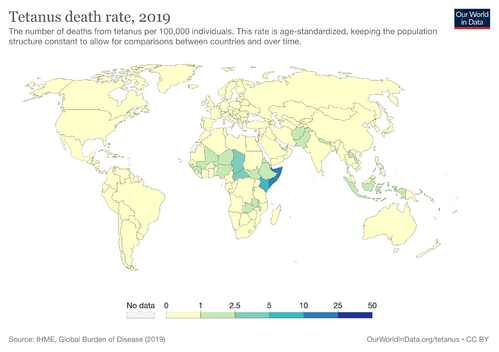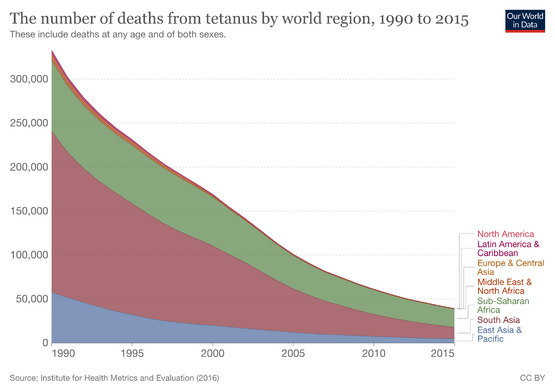Tetanus: Difference between revisions
No edit summary |
No edit summary |
||
| Line 5: | Line 5: | ||
</div> | </div> | ||
== Introduction == | == Introduction == | ||
[[File:Tetanus-death-rate.png| | [[File:Tetanus-death-rate.png|alt=|right|frameless|499x499px]] | ||
Tetanus is an infection that causes state of generalised [[Hypertonia Assessment Tool|hypertonia]] that presents in the form of painful muscle spasms of the jaw and neck. The disease most commonly occurs in those who are not vaccinated or in the [[Older People Introduction|elderly]] with waning immunity. Recently, vaccination campaigns have decreased the incidence and prevalence of tetanus worldwide. Symptoms are caused by toxins produced by the [[Bacterial Infections|bacterium]], Clostridium tetani.<ref name=":0">Bae C, Bourget D. Tetanus.[Updated 2020 May 28]. StatPearls [Internet]. Treasure Island (FL): StatPearls Publishing. 2021.Available:https://www.statpearls.com/articlelibrary/viewarticle/29997/ (accessed 17.12.2022)</ref> | Tetanus is an infection that causes state of generalised [[Hypertonia Assessment Tool|hypertonia]] that presents in the form of painful muscle spasms of the jaw and neck. The disease most commonly occurs in those who are not vaccinated or in the [[Older People Introduction|elderly]] with waning immunity. Recently, vaccination campaigns have decreased the incidence and prevalence of tetanus worldwide. Symptoms are caused by toxins produced by the [[Bacterial Infections|bacterium]], Clostridium tetani.<ref name=":0">Bae C, Bourget D. Tetanus.[Updated 2020 May 28]. StatPearls [Internet]. Treasure Island (FL): StatPearls Publishing. 2021.Available:https://www.statpearls.com/articlelibrary/viewarticle/29997/ (accessed 17.12.2022)</ref> | ||
== Etiology == | == Etiology == | ||
[[Image:Untitled1.jpg|frame|right|Clostridium tetani bacteria]]The most common way the bacterium enters the body is through wounds which are susceptible to infection if they are: contaminated with soil, feces, or saliva; puncture wounds including unsterile injection sites; devitalized tissue including burns, avulsions and degloving injuries. When in the body the bacterium secretes toxin, | [[Image:Untitled1.jpg|frame|right|Clostridium tetani bacteria]]The most common way the bacterium enters the body is through [[Wound Assessment|wounds]] which are susceptible to infection if they are: contaminated with soil, feces, or saliva; puncture wounds including unsterile injection sites; devitalized tissue including [[Burns Overview|burns]], avulsions and degloving injuries. | ||
When in the body the bacterium secretes toxin,<ref name="Ewcombe">Ewcombe P. Treating and preventing tetanus in A&E. Emergency Nurse. October 2004;12(6):23-29.</ref>Tetanus toxin causes the typical clinical manifestations of tetanus by interfering with the release of neurotransmitters and blocking inhibitor impulses. This leads to unopposed muscle contraction and spasm. Seizures may occur, and the autonomic nervous system may also be affected.<ref>NSN search How does tetanus affect muscle contraction? Available: https://nsnsearch.com/how-to/how-does-tetanus-affect-muscle-contraction/ (accessed 18.12.20220</ref> | |||
The two toxins secreted into the bloodstream are: | The two toxins secreted into the bloodstream are: | ||
# Tetanospasmin affects the nerve and muscle motor endplate interaction, causing the clinical syndrome of rigidity, muscle spasms, and autonomic instability. | # Tetanospasmin affects the [[Neurone|nerve]] and muscle motor endplate interaction, causing the clinical syndrome of rigidity, muscle spasms, and autonomic instability. | ||
# Tetanolysin damages the tissues.<ref name=":0" /> | # Tetanolysin damages the tissues.<ref name=":0" /> | ||
== Epidemiology == | == Epidemiology == | ||
[[File:The-number-of-deaths-from-tetanus-by-world-region.png|right|frameless|555x555px|Number of-deaths-from-tetanus]] | |||
Although tetanus affects people of all ages; however, the highest prevalence is seen in newborns and young persons. The World Health Organization (WHO) reports improvement in mortality rates from tetanus, related with combative vaccination campaigns in recent years. The WHO estimates worldwide tetanus deaths in 1997 at around 275,000 with improved rates in 2011 at 14,132 cases.<ref name=":0" /> | Although tetanus affects people of all ages; however, the highest prevalence is seen in newborns and young persons. The World Health Organization (WHO) reports improvement in mortality rates from tetanus, related with combative vaccination campaigns in recent years. The WHO estimates worldwide tetanus deaths in 1997 at around 275,000 with improved rates in 2011 at 14,132 cases.<ref name=":0" /> | ||
| Line 30: | Line 33: | ||
* headache | * headache | ||
* fever and sweating | * fever and sweating | ||
* changes in blood pressure or fast heart rate.<ref name=":1">WHO Tetanus Available:https://www.who.int/news-room/fact-sheets/detail/tetanus (accessed 17.12.2022)</ref>[[Image:Neonatal tetanus.jpg|thumb|right|Neonatal muscluar rigidity and spasms]] | * changes in [[Blood Pressure|blood pressure]] or [[Tachycardia|fast heart rate]].<ref name=":1">WHO Tetanus Available:https://www.who.int/news-room/fact-sheets/detail/tetanus (accessed 17.12.2022)</ref> | ||
[[Image:Neonatal tetanus.jpg|thumb|right|Neonatal muscluar rigidity and spasms]]Neonatal tetanus causes more than 50% of deaths from tetanus worldwide but is very rare in developed countries. Neonates present within a week of birth with a short history of failure to feed, vomiting, and ‘convulsions’. Spasms are generalized and mortality is high. Poor umbilical hygiene is the cause of the disease which is preventable by maternal [[Vaccines|vaccination]], even during pregnancy.<ref>Cook TM, Protheroe RT, Handel JM. Tetanus: a review of the literature. British Journal of Anaesthesia. 2001 Sep 1;87(3):477-87. Available: https://academic.oup.com/bja/article/87/3/477/333174?login=false<nowiki/>(accessed 18.12.2022)</ref> | |||
Neonatal tetanus | |||
== Treatment == | == Treatment == | ||
Tetanus is a medical emergency requiring: | Tetanus is a medical emergency requiring: | ||
| Line 48: | Line 50: | ||
== Diagnosis == | == Diagnosis == | ||
There are no specific laboratory or diagnostic tests used to diagnosis tetanus. The diagnosis is made based on clinical signs and symptoms and not on the confirmation of the bacteria C. tetani in the body. <ref name="CDC" /><ref name="Grunau">Grunau B, Olson J. An interesting presentation of pediatric tetanus. CJEM: Canadian Journal Of Emergency Medical Care = JCMU: Journal Canadien De Soins Médicaux D'urgence. January 2010;12(1):69-72. Available from: MEDLINE, Ipswich, MA. Accessed March 16, 2011.</ref>“C. tetani is recovered from the wound in only 30% of cases and can be isolated from patients who do not have tetanus.”<sup><ref name="CDC" /></sup> | There are no specific laboratory or diagnostic tests used to diagnosis tetanus. The diagnosis is made based on clinical signs and symptoms and not on the confirmation of the bacteria C. tetani in the body. <ref name="CDC">CDC. Tetanus: Questions and Answers. November 2010.www.immunize.org.</ref><ref name="Grunau">Grunau B, Olson J. An interesting presentation of pediatric tetanus. CJEM: Canadian Journal Of Emergency Medical Care = JCMU: Journal Canadien De Soins Médicaux D'urgence. January 2010;12(1):69-72. Available from: MEDLINE, Ipswich, MA. Accessed March 16, 2011.</ref>“C. tetani is recovered from the wound in only 30% of cases and can be isolated from patients who do not have tetanus.”<sup><ref name="CDC" /></sup> | ||
== Physical Therapy Management == | == Physical Therapy Management == | ||
Revision as of 02:41, 18 December 2022
Original Editors - Natalie Gutmann from Bellarmine University's Pathophysiology of Complex Patient Problems project.
Top Contributors - Natalie Gutmann, Elaine Lonnemann, Lucinda hampton, Admin, Kim Jackson, WikiSysop, Wendy Walker and 127.0.0.1
Introduction[edit | edit source]
Tetanus is an infection that causes state of generalised hypertonia that presents in the form of painful muscle spasms of the jaw and neck. The disease most commonly occurs in those who are not vaccinated or in the elderly with waning immunity. Recently, vaccination campaigns have decreased the incidence and prevalence of tetanus worldwide. Symptoms are caused by toxins produced by the bacterium, Clostridium tetani.[1]
Etiology[edit | edit source]
The most common way the bacterium enters the body is through wounds which are susceptible to infection if they are: contaminated with soil, feces, or saliva; puncture wounds including unsterile injection sites; devitalized tissue including burns, avulsions and degloving injuries.
When in the body the bacterium secretes toxin,[2]Tetanus toxin causes the typical clinical manifestations of tetanus by interfering with the release of neurotransmitters and blocking inhibitor impulses. This leads to unopposed muscle contraction and spasm. Seizures may occur, and the autonomic nervous system may also be affected.[3]
The two toxins secreted into the bloodstream are:
- Tetanospasmin affects the nerve and muscle motor endplate interaction, causing the clinical syndrome of rigidity, muscle spasms, and autonomic instability.
- Tetanolysin damages the tissues.[1]
Epidemiology[edit | edit source]
Although tetanus affects people of all ages; however, the highest prevalence is seen in newborns and young persons. The World Health Organization (WHO) reports improvement in mortality rates from tetanus, related with combative vaccination campaigns in recent years. The WHO estimates worldwide tetanus deaths in 1997 at around 275,000 with improved rates in 2011 at 14,132 cases.[1]
Presentation[edit | edit source]
The incubation period of tetanus varies between 3 and 21 days after infection, with most cases occur within 14 days.
Symptoms can include:
- jaw cramping or the inability to open the mouth
- muscle spasms often in the back, abdomen and extremities
- sudden painful muscle spasms often triggered by sudden noises
- trouble swallowing
- seizures
- headache
- fever and sweating
- changes in blood pressure or fast heart rate.[4]
Neonatal tetanus causes more than 50% of deaths from tetanus worldwide but is very rare in developed countries. Neonates present within a week of birth with a short history of failure to feed, vomiting, and ‘convulsions’. Spasms are generalized and mortality is high. Poor umbilical hygiene is the cause of the disease which is preventable by maternal vaccination, even during pregnancy.[5]
Treatment[edit | edit source]
Tetanus is a medical emergency requiring:
- Care in the hospital
- Early intramuscular or intravenous administration of the human tetanus immunoglobulin (HTIG). Removes released tetanospasmin toxin; however, it does not affect the toxin that is already bound to the central nervous system.
- Aggressive wound care
- Antispasmodics eg benzodiazepines, baclofen, vecuronium, pancuronium, and propofol
- Antibiotic therapy (metronidazole, slows progression of disease)[1]
- Tetanus vaccination.
Patients with severe symptoms need to be admitted to the ICU for close monitoring and mechanical ventilation. Healthcare providers need to provide supportive care, especially for patients with autonomic instability (labile blood pressure, hyperpyrexia, hypothermia).
Rehabilitation may take weeks or months.[4]
Diagnosis[edit | edit source]
There are no specific laboratory or diagnostic tests used to diagnosis tetanus. The diagnosis is made based on clinical signs and symptoms and not on the confirmation of the bacteria C. tetani in the body. [6][7]“C. tetani is recovered from the wound in only 30% of cases and can be isolated from patients who do not have tetanus.”[6]
Physical Therapy Management[edit | edit source]
Currently research is limited on the Physical therapy management of individuals with tetanus. Cardiopulmonary physical therapy can be used to help in the prevention of respiratory complications.[8] Physical therapy can also be used to help with muscle rigidity and spasms.
References[edit | edit source]
- ↑ 1.0 1.1 1.2 1.3 Bae C, Bourget D. Tetanus.[Updated 2020 May 28]. StatPearls [Internet]. Treasure Island (FL): StatPearls Publishing. 2021.Available:https://www.statpearls.com/articlelibrary/viewarticle/29997/ (accessed 17.12.2022)
- ↑ Ewcombe P. Treating and preventing tetanus in A&E. Emergency Nurse. October 2004;12(6):23-29.
- ↑ NSN search How does tetanus affect muscle contraction? Available: https://nsnsearch.com/how-to/how-does-tetanus-affect-muscle-contraction/ (accessed 18.12.20220
- ↑ 4.0 4.1 WHO Tetanus Available:https://www.who.int/news-room/fact-sheets/detail/tetanus (accessed 17.12.2022)
- ↑ Cook TM, Protheroe RT, Handel JM. Tetanus: a review of the literature. British Journal of Anaesthesia. 2001 Sep 1;87(3):477-87. Available: https://academic.oup.com/bja/article/87/3/477/333174?login=false(accessed 18.12.2022)
- ↑ 6.0 6.1 CDC. Tetanus: Questions and Answers. November 2010.www.immunize.org.
- ↑ Grunau B, Olson J. An interesting presentation of pediatric tetanus. CJEM: Canadian Journal Of Emergency Medical Care = JCMU: Journal Canadien De Soins Médicaux D'urgence. January 2010;12(1):69-72. Available from: MEDLINE, Ipswich, MA. Accessed March 16, 2011.
- ↑ Cook T, Protheroe R, Handel J. Tetanus: a review of the literature. British Journal Of Anaesthesia. September 2001;87(3):477-487. Available from: MEDLINE, Ipswich, MA. Accessed April 2, 2011.









